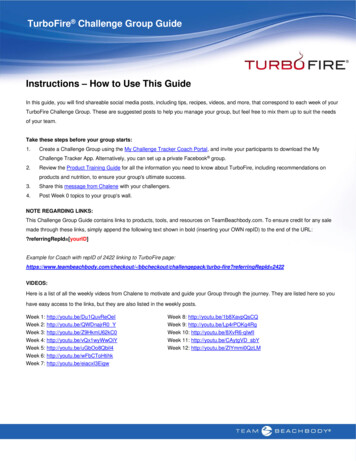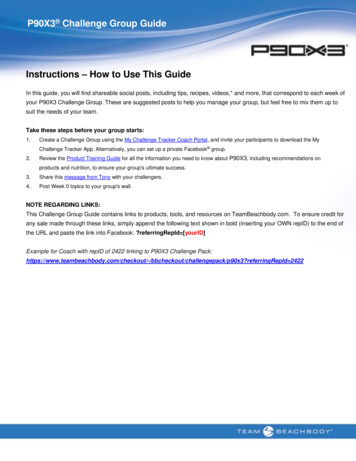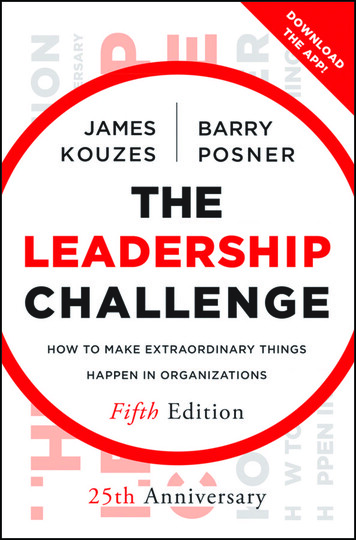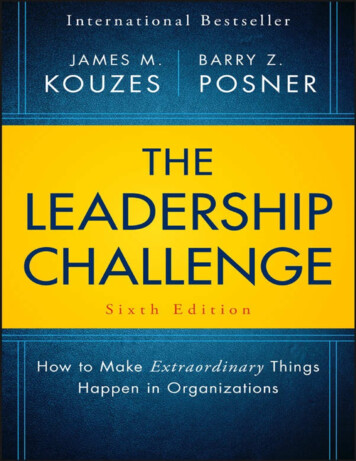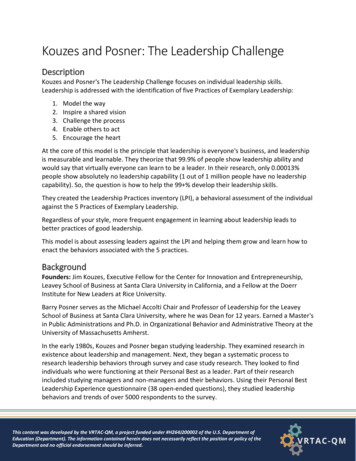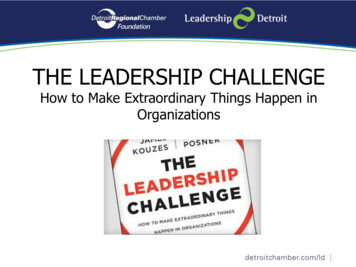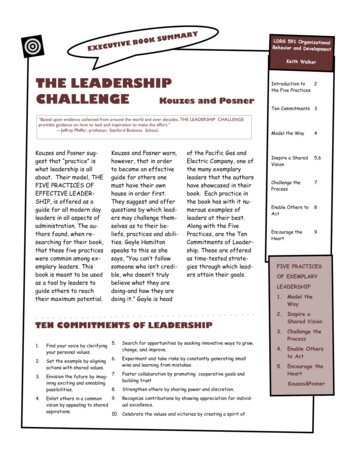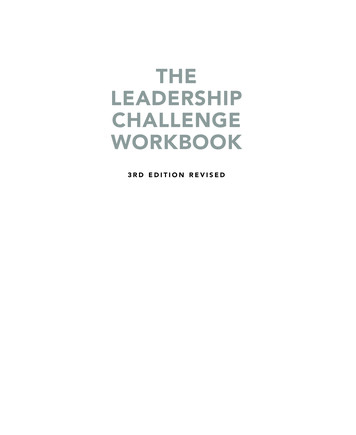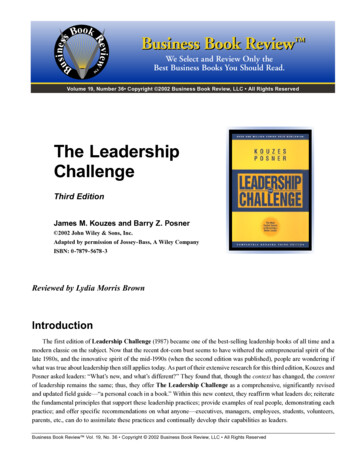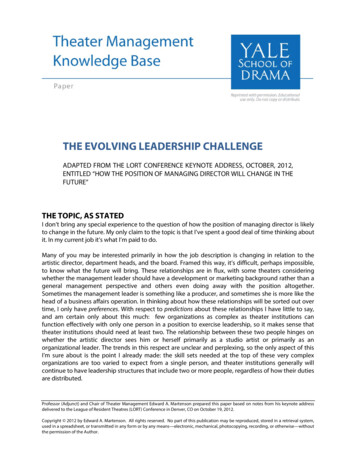
Transcription
Discussion paperAuthorRichard W GiordanoThe leadership challenge forgeneral practice in EnglandAn Inquiry into the Quality of General Practice in England
The leadership challenge forgeneral practice in EnglandA personal view on working in a zone of emergenceRichard W GiordanoSenior Lecturer, Leadership andManagement in Health and Social CareSchool of Health SciencesUniversity of SouthamptonSouthampton SO17 1BJr.giordano@soton.ac.uk
1 IntroductionThe White Paper Equity and Excellence: Liberating the NHS (Department ofHealth 2010) sets out a vision for the National Health Service that promisesto be one the most extensive reforms in its history, and the role of thegeneral practitioner (GP) is at its heart. These reforms are intended, inpart, to create co-ordinated care close to the communities where patientslive, with the patient experiencing seamless and frictionless care no matterwhere it is practiced. General practice will be given new commissioningresponsibilities, and will be able to design integrated care pathways forpatients that span primary, secondary and social care. GPs will co-ordinatecare, and integrate information and knowledge derived from many sourcesfor a single patient.The principal interactions between the patient and health care will thereforebe through general practice: the practice will be both the starting andthe ongoing reference points for most patients. Consequently, generalpractitioners will need to build working relationships with all aspects ofhealth and social care, including local authorities and secondary care. Suchrelationships are new for general practice, and new leadership capabilitiesare needed to prepare GPs for them.However, there is little mention of which leadership capabilities arenecessary for general practitioners to bring about these reforms, eitherin the White Paper or in the National Leadership Council’s consolidatedbusiness case 2010–11 (Dept. of Health 2009). This discussion paperattempts to outline a set of leadership capabilities appropriate to GP leaderswho work across organisational and functional boundaries. It builds on theRoyal College of General Practitioners (RCGP) publications Being a GeneralPractitioner (RCGP 2007a) and The Future of General Practice: A roadmap(RCGP 2007b, referred to here as ‘the Roadmap’, and should not be seen asa replacement for either. Instead, it attempts to augment both, given thecontext of the White Paper.The discussion paper does not attempt to examine all aspects of leadershipdevelopment and organisational development implied by the White Paper.Instead, it focuses on how GPs can build relationships across functional andorganisational boundaries that engender processes and behaviours that areresponsive to local contexts, adaptive to change and innovative. It is notintended as a final, discrete set of necessary GP leadership competencies,and should not be construed as such. Instead, it identifies the managementof complex relationships as the kernel of GP leadership in a new NHS, andoutlines some approaches that should spawn timely discussion and debate inadvance of the proposed reforms.2 The King’s Fund 2011
2 The primacy of the doctor–patientrelationshipThere can be little doubt of the importance of the GP in everyone’s life. GPsplay a central role in society because, as Ferrer et al (2005, p 691) says,both plainly and accurately, ‘Health care is an essential means for promotinghuman development’. Any discussion of general practice should thereforestart with the essential human relationship in medical practice – thedoctor–patient relationship – because, from the patient’s perspective, thequality and key characteristics of that relationship are, in many instances,everything. Every citizen has a right to be registered with a GP, and this rightshould bring them access to personal and organisational continuity of care,comprehensiveness and co-ordination. The doctor–patient relationship isparticularly important for certain groups, because GPs often play the role ofa safety net – especially for the most vulnerable (RCGP 2007a).The role that GPs play in society suggests that the quality of theirinteractions with patients has a special significance. With more than 90per cent of interactions between the public and the National Health Servicetaking place in primary care settings, the GP is the public face of the healthservice (Jackson and Burton 2003). Care for the whole person, informed bythe person’s values, beliefs and community, along with health interventionsconstructed in participation with the patient, comprise the core values ofgeneral practice (RCGP 2007a).Unlike many specialists or consultants, such as surgeons or dermatologists,GPs largely practice ‘cognitively’. They search for patterns throughobservation and dialogue with the patient, and through this build both apersonal relationship and an understanding of the patient’s biological,psychological and sociological states – the Biopsychosocial model (Engel1977; Frankel et al 2003). Indeed, many patients expect GPs to form close,long-term relationships based on trust, mutual respect and understanding(Kearley et al 2001). This is especially true for the most vulnerable patientsand their caregivers, who may have multiple long-term conditions, complexconditions, serious illness or emotional or psychological problems (Kottkeetal 2008; Schers et al 2002; Tarrant et al 2003) problems.11There are some caveats to the role of the doctor–patient relationship, interpersonalcontinuity of care and patient satisfaction. In many cases, interpersonal continuity of care andpatient satisfaction are not causally related. What seems to matter most for all patients is thequality of the encounter with the GP; patients will tend to switch GPs if they are dissatisfiedwith the quality of the encounter even if they enjoy a long-term It should be noted thatinterpersonal continuity of care and patient satisfaction are, in many cases, not causally related.What seems to matter most for all patients is the quality of the encounter with the GP; patientswill tend to switch GPs if they are dissatisfied with the quality of the encounter even if theyenjoy a long-term relationship with that GP. The quality of the consultation rests on encounterswhere the GP recognises the patient and remembers the patient’s previous ailment or condition,(Frederickson et al 2009) or when a patient believes that the GP is treating the person, notjust the illness, (Tarrant et al 2003) and where the patient believes that s/he is being heard,understood, and shown respect. (Williams et al 1995). Younger patients and those with minoracute conditions or minor injuries do not necessary value interpersonal continuity (Fletcheretal 1995), but being heard and shown respect count high in influencing the level of satisfactionwith their care. Furthermore, it is not unknown for patient satisfaction to rest occasionally onunrealistic demands, such as the overuse of diagnostic testing to re-assure a healthy patient.[Kravitz & Edward, 2000] For example, one study quotes a patient, ‘I would like to have a testfor all diseases you can possibly get. So that at least you know that you’re in good health anddon’t have to worry. If your blood is okay, that means you’re healthy’ (van Bokhaven 2006, p 3).3 The King’s Fund 2011
GP Inquiry PaperThe web of relationshipsImportant as it is, the doctor–patient relationship is just one of a web ofrelationships for the GP. GPs are the anchor of the health care system,who should have knowledge both of individuals and populations (Curry etal 2008), who sit at the intersection of medicine, public health and socialcare (Blue Ribbon Panel of the Society of General Internal Medicine 2007;Rosenthal 2008) and who are expected by government to make the best, andmost efficient, use of resources available in a health economy (Curry et al2008).As we saw in the introduction, in 2007 the RCGP laid out its Roadmap forthe future direction of general practice (RCGP 2007b). In this new model ofcare, the GP provides a comprehensive service that brings treatment andinterventions closer to the community, brings co-ordination to a range ofproviders, and makes the GP practice the basic unit of care. Comprehensiveservices – many of which are now provided only in hospitals – would beoffered partly through formal or informal federations, or consortia, ofGP practices. Moreover, the Roadmap called for increased GP accessto diagnostics and improved continuity of care – in particular, interorganisational continuity.The Roadmap envisaged part of the GP role as being to design and coordinate care pathways that span health care teams and organisations. Whilespecialist teams located at acute trusts and elsewhere may have discreteknowledge of the patient, or the disease, the GP is the critical link thatmaintains the big picture. In effect, for the GP this means that the distinctionbetween secondary care and primary care is blurred, as is the distinctionbetween social care and health care. General practice is therefore the crucialcomponent in creating frictionless, holistic care for the patient.This vision is echoed – indeed, amplified – in the most recent White Paperon the future of the NHS (Department of Health 2010). Although the detailsof the proposed changes will emerge in the final drafts of the Health CareBill, due in 2011, the White Paper calls for commissioning to move to localconsortia or federations of GP practices, shifting PCT responsibilities to localauthorities, and for GPs to design care pathways and packages for patients.The White Paper also calls for the systematic integration of health andsocial care, particularly for mental illness. Despite many uncertainties, it isapparent that the GP will play a central co-ordinating role for all patients inprimary care, secondary care, social care and health promotion.2So, the doctor–patient relationship is just one of a set of relationships, whichwill include those: between the GP and members of interdisciplinary health care teams(including secondary care) between the GP and health care systems and the community (includinglocal authorities and social care)2For example, aside from commissioning powers, it is not clear if GP consortia orfederations will provide the range of services envisaged by the RCGP Roadmap or if theprimary logic of consortia is to create economies of scale and risk pooling in commissioning(see Ham 2010). See also Ham, 8 July 2010. While the details of the proposed integration ofcare are currently hazy, the White Paper indicates that GP consortia will have a duty to promoteequalities and to work in partnership with local authorities in relation to health and socialcare, early years services, public health and the well-being of local populations (Department ofHealth 2010, p 29).4 The King’s Fund 2011
GP Inquiry Paper between the GP and management professionals, such as financialdirectors between the GP and local or regional policy professionals.These extended relationships are not unknown to the GP, but they aregenerally unfamiliar territory in their day-to-day work. To make sense ofthese relationship and to use them effectively, GPs need to understandthemselves well enough to know when to ask for help, and to be aware ofand honest about their own professional and personal values when makingdecisions. In addition to the relationships outlined above, we thereforebelieve that the GPs as leaders build a relationship between their clinicianidentity and themselves (Tresolini 1994).The White Paper and the Roadmap correctly suggest that the web ofrelationships that GPs need to navigate will be increasingly complex inthe coming years. Such relationships are fundamental to effective healthcare. GPs will therefore need to engage in ‘a complex responsive process ofrelating’ (Suchman 2006). The critical leadership challenge is to build thecapacity of GPs to navigate these waters.Leadership capacities in a world of complex relationshipsIn order to make the most of the planned changes for the NHS, and to followthe RCGP Roadmap, GPs will need to develop a set of leadership capacitiesthat enable them to influence people and events, and to maintain excellentcare for every patient. A set of necessary but insufficient capacities includenew or enhanced skills in: change management at the practice level strategic management and planning (particularly for the development ofconsortia and federations) building leadership capacity among GPs to support lagging GP practices knowing how to interact with news media influencing local and national politicians influencing policy serving on and chairing boards at both the consortia and secondary carelevels knowing how to work effectively with management, and knowing when/how to use managerial support having excellent financial management skills building teams within and across organisational and functional boundaries.Important as these leadership capacities and skills are, they are insufficientbecause they do not engender flexibility, innovation, and creativity alignedwith existing (and future) local contexts and needs. There is somethingspecial about the structure and relations outlined in the White Paper and,to some extent, the RCGP Roadmap. Organisations are to become asautonomous from central control as possible and to develop and enact theirown solutions to local circumstances. The White Paper is particularly clearthat a centrally driven, target-oriented culture will be replaced with a culturethat encourages local initiatives (spanning functional and organisationalboundaries) that respond to local needs (that are both locally and nationally5 The King’s Fund 2011
GP Inquiry Paperaccountable) and increase clinical quality and efficiency.If nothing else, this means that local health care organisations must become,and remain, aligned with emergent local conditions, and develop servicesthat best respond to them.Aside from co-ordination, some new key capacities are needed to make thiswork, including: an organisational ability to self-organise quickly an organisational ability to learn and adapt a willingness to engender leadership behaviours in everyone at all levelsand function of the organisation a culture of innovation the ability, among all parties, to understand at once the local context –from a unit as small as the office visit to the big picture (national policy)– and their place in it.The challenges of meeting the goals of the White Paper are immense. Itis supremely difficult to co-ordinate across functional and organisationalboundaries – for example, by integrating health and social care, or bytruly co-ordinating primary and secondary care so that the result appearsseamless or frictionless to the patient – because the world views ofpeople working in different organisations, or different functional areas,are strikingly dissimilar. What may be important for one group will beunimportant to the other.Consider, for example, how different groups might define ‘good quality oflife’. The economist may explain the concept in terms an individual or group’scapacity to acquire scarce resources, the philosopher might focus on theability of the individual to achieve authenticity, the psychologist might focus onthe ability of the individual to know him or herself and construct a coherent lifenarrative, while the clinician might define quality in terms of health.Moreover, over time different groups may rely on habits of working andthinking in order to get the day-to-day work done. Consider the challengeof trying to persuade a district nurse to think in the style of social worker, orvice versa. If we consider funding streams, we will find that social workersmay not think like district nurses—even if they wanted to—because theyare neither paid nor rewarded to think like district nurses. The habits ofthinking and the institutional structures that support them create a pathdependency in work and thinking that is hard to overcome (Carlile 2004; Starand Griesemar 1989). Consequently, there is an inbuilt tension when workingacross boundaries (Lichtenstein et al 2006) when different work styles,habits, values and rewards become clear and, indeed, clash.How can we overcome this tension? The solution to the problem lies in theproblem itself.6 The King’s Fund 2011
3 Zones of emergenceTo lead across organisational and functional boundaries, the GP leader hasto build and then nurture complex relationships, and to ensure that thoserelationships result in innovative behaviours that are responsive to localcontexts. This is hard to do because, as we have seen, each group in the webof relationships already has its own ways of doing things that are difficult tochange.Recent sociological and business studies suggest that path-dependentknowledge – relying on habits and thought styles peculiar to a group –hinders new ways of doing things. This research, however, also stronglysuggests that the act itself of bridging a boundary between functionalgroups helps to break that path dependency, and tends to create new waysof thinking and behaving (see Burt 1992 and Carlile 2004). The tension thatoften accompanies the bridging of two or more groups occurs because bothgroups are holding on to past ways of working and thinking while beingconfronted with new ideas and practices as they interact and as each groupmakes explicit its values and beliefs.The interaction among members of different functional or role groups bringsto the surface new ways of working and thinking that become explicit. Themore diverse the group, the more diverse the clashing ideas, practices, andthoughts—and the greater the chances for innovative approaches. It is in thisspace, where neither group knows what it doesn’t know, where new knowledgeand practices are created. We can call this space a ‘zone of emergence’.But innovation in a zone of emergence does not happen on its own – if it did,then the landscape would be abundant with innovation. In most cases, thistension results either in gridlock or an acceptance of the status quo. Makingthe most of interactions in a zone of emergence requires a special kind ofrelational or adaptive leadership (Lichtenstein et al 2006) to take advantageof the tension and clash that comes with that territory. Leadership in thiscontext is not about persuading people to follow the leader, but generatingthe conditions for participants to create new outcomes and processes.A leader in a zone of emergence views all participants as leaders, andencourages them to negotiate. The leader has the self-awareness andconfidence to drive responsibility downwards, so that diverse ideas andpractices held by diverse individuals can spark innovation, responsiveness,adaptation and self-organisation (Heifetz et al 2009).Butler and Allen (2008) argue that this type of leader creates theseconditions by:7 The King’s Fund 2011 widening the space of possible solutions and approaches reframing decision-making to be as open as possible and acknowledgingthat there is no single best practice (because best practice depends oncontext) engendering learning and creativity reviewing and learning from past successes and failures continuously reflecting on and adapting how they enact leadership, visionand implementation.
GP Inquiry PaperRelational and adaptive leadership capacities and behavioursAfter reading the White Paper, a GP said to me ‘This is a new game – howare we going to learn it together?’ A cursory review of the literature providessome pointers (Butler and Allen 2008; Eriksen 2008; Heifetz et al 2009;Lichtenstein et al 2006; Proudfoot et al 2007; Roland 2007; Rushmer et al2007, 2004a, 2004b, 2004c; Troop 2003).The GP leader has to build an honest relationship between the self as a GPand the self as a whole person. When working in a zone of emergence, theGP leader will call on those relationship qualities that create the trusteddoctor–patient relationship. They may sometimes have to face theirown latent arrogance, learn humility, listen to the whole person, and becomfortable sitting with uncertainty. Most of all, they have to build thecapacity to learn with others.We offer some key advice for GPs to build relationships across functionaland organisation boundaries, and to encourage innovative thinking to localproblems and contexts. Be comfortable with uncertainty Working across boundariesoften means that we are working in complex environments. Complexenvironments, by their nature, are not stable – they adapt. You will bea leader of adaptive change. Your key role is to manage relationshipsand interactions, and ensure that new ways of working and innovationemerge from those interactions. Be honest with yourself Know your own assumptions, your likes anddislikes, your pet solutions and approaches. Reflect on how these affectyour behaviours with others, and be especially aware of how they mightstop conversations, debate and creativity among those with whom youwork. In order to effect change, the adaptive leader working in a zone ofemergence needs to practice self-authorship to become the person theywant to become. Drive responsibility downwards Everyone has the capacity to lead,and everyone has expertise. As contexts change and new approachesare needed, assume that someone in the group has that expertise andcan lead on an approach or solution. Identify emerging leaders by valuing autonomy Draw on peoplefrom the group to come up with solutions, and prepare and encouragethem to develop innovative organisational experiments. Give themroom to think and explore. As well as encouraging innovative practices,this helps to identify new, emergent leaders who think creatively andindependently. Tolerate and engender disagreement, and don’t strive forconsensus Working across boundaries means that the leader will beworking with diverse views and diverse knowledge. Harness this diversityin the service of creative solutions. Encourage healthy debate rather thancynical disagreement, and use such debate to surface divergent viewsthat lead to better and responsive services. Ask new questions of the team that reveal assumptions, mentalmodels, contradictions and tensions Make sure that the team clearlysees these assumptions too, and works with them. Making assumptionsexplicit helps everyone to understand what is important to individuals,8 The King’s Fund 2011
GP Inquiry Paperand helps to create the conditions where participants can identify andmake trade-offs. In the best circumstances, individuals learn from eachother and help to create new ways of thinking and new ways of behaving.9 The King’s Fund 2011 Observe and listen Make sure the team members knows that you haveheard them. Avoid posing your own pet solutions or processes. See possibilities rather than impediments Widen the rangeof possible approaches. One way of doing this is to invite a range ofsolutions from all team members and encourage them to ask ‘Why not ?’or ‘What if ?’. Develop the ability to influence others The leader often has tonegotiate and persuade individuals and groups from other organisations,practices, professions and cultures. Understand how others evaluateand understand what you are saying, and how your behaviours areinterpreted by them. Support and develop others View members of your team asindividuals who have the capacity and willingness to learn, and help themidentify and build on their strengths. Strive for duplicative and redundant knowledge among membersThis builds adaptability in the team, and allows members to understandhow others work, and what is important about each other’s work. Be willing to be a co-learner If the focus of the group is to learn andto innovate, leaders at all levels must show a willingness to learn andapply learning to innovative practices. Be self-critical, and seek ways toimprove your own performance. Help people through change, and support mistakes Most learningsystems learn what to do by learning what not to do, through experience.Mistakes, false starts and blind alleys are a fact of life in any learningenvironment. The key is to learn from a mistake. Mentor your team Set an example to others by reflecting on yourpractice and seeking ways of improving it. Set aside time and space where learning and reflection areboth encouraged and expected The leader encourages two kinds oflearning: double-loop (what are we learning from our work) and tripleloop (how are we learning). No group can adapt and change unlesslearning is encouraged, takes place, and is applied.
ConclusionsThe vision of GPs at the nexus of health and social care is exciting, andpromises to deliver seamless care for patients. However, it will call on GPsto identify and build relationships across organisational and functionalboundaries. The leadership challenges are considerable. GPs have notnormally worked in this way, and there are inherent barriers to workingeffectively across functional roles.The boundaries – and the tension they create among groups (the zone ofemergence) – offer real opportunities to create innovative services that areresponsive to local needs, and that can constantly adapt. But identifyingand taking advantage of these opportunities does not spring from thin air. Itdemands a set of leadership skills from the GP that is focused on building andmanaging relationships, and on encouraging innovation through interactionsthat emerge from those relationships.10 The King’s Fund 2011
QuestionsThis paper is designed to stimulate discussion, and we look forward tohearing from readers with their own views. The following questions mightencourage debate:11 The King’s Fund 2011 Do you agree with our assessment of the leadership challenge facing GPs? What other approaches to leadership is useful, given the White Paper? What roles can the royal colleges and other organisations play in meetingGPs’ leadership needs? Who should pay for GP leadership development? What skills are needed to manage GP consortia? Should GPs develop management and financial skills, or should they learnhow to work effectively with non-clinical management professionals whohave those skills? Do you believe that there should be a National Leadership CompetencyFramework for GPs? What else can be done?
AcknowledgementsThe author wishes to thank Paul England, Professor Steve Field, Dr GeorgeFreeman, Dr Lis Rodgers, and Dr Katy Steward for their helpful advice andcomments on a previous iteration of this paper. Dr Alastair Honeyman’sinterest in complexity was especially helpful.12 The King’s Fund 2011
BibliographyBlue Ribbon Panel of the Society of General Internal Medicine (2007).‘Redesigning the practice model for general internal medicine: a proposal forcoordinated care’. Journal of General Internal Medicine, vol 22, no 3, pp 400–9.Burt RS (1992). Structural Holes: The structure of competition. Cambridge, MA:Harvard University Press.Butler MJR, Allen PM (2008). ‘Understanding policy implementation processes asself-organizing systems’. Public Management Review, vol 10, no 3, pp 421–40.Carlile P (2004). ‘Transferring, translating and transforming: an integrativeframework for managing knowledge across boundaries’. Organization Science,vol 15, no 5, pp 555–68.Curry N, Goodwin, N, Robertson, R(2008). Practice Based Commissioning:Reinvigorate, replace or abandon? London: The King’s Fund.Department of Health (2010). Equity and Excellence: Liberating the NHS. WhitePaper. London: HMSO.Department of Health. National Leadership Council (2009). NLC Work Streams2010/2011. Consolidated business case, London: Department of Health.Engel GL (1977). ‘The need for a new medical model: a challenge for biomedicine’.Science, vol 196, pp 219–22.Eriksen M (2008). ‘Leading adaptive organizational change: self-reflexivity andself-transformation’. Journal of Organizational Change Management, vol 21, no 5,pp 622–40.Ferrer RL , Hambidge SJ, Maly RC (2005). ‘The essential role of the generalist inhealth care systems’. Annals of Internal Medicine, vol 142, pp 691–99.Fletcher RH, O’Malley MS, Earp JA, Littleton BA, Fletcher SW, Greganti MA,Davidson RA, Taylor J (1983). ‘Patients’ priorities for medical care’. Medical Care,vol 21, no 2, pp 234–42.Frankel RM, Quill TE, McDaniel S (2003). The Biopsychosocial Approach: Presentand future. Rochester, NY: University of Rochester Press.Fredericksen HB, Kragstrup J, Dehlholm-Lambertsen G (2009). ‘It’s all aboutrecognition: qualitative study of the value of interpersonal continuity in generalpractice’. BMC Family Practice, vol 10, p 47.Ham C (2010). ‘Ten challenging questions about the White Paper’. Blog. London:The King’s Fund. Available at: www.kingsfund.org.uk/blog/ten challenging.html(accessed on 23 November 2010).Heifetz R, Grashow A, Linsky M (2009). ‘Leadership in a (permanent) crisis’.Harvard Business Review, July–August, pp 62–69.Jackson N, Burton J (2003). ‘The practice as a learning organization’ in Burton J,Jackson N (eds) Work Based Learning in Primary Care. Abingdon: Radcliffe.Kearley KE, Freeman GK, Heath A (2001). ‘An exploration of the value of thepersonal doctor–patient relationship in general practice’. British Journal ofGeneral Practice, vol 51, pp 712–18.Kottke TE, Solberg LI, Nelson AF, Belcher DW, Caplan W, Green LW, Lydick E,Magid DJ, Rolnick SJ, Woolf SH (2008). ‘Optimizing practice through research: anew perspective to solve an old problem’. Annals of Family Medicine, vol 6, no 5,pp 459–62.Kravitz RL, Edward JC (2000). ‘Patients’ perceptions of omitted examinationsand tests: a qualitative analysis’. Journal of General Internal Medicine, vol 15, pp38–45.Lichtenstein BB, Uhhl-Bien M, Marion R, Seers A, Orton JD, Schreiber C (2006)‘Complexity leadership theory: an interactive perspective on leading in complex13 The King’s Fund 2011
GP Inquiry Paperadaptive systems’. Emergence: Complexity and Organization, vol 8, no 4, pp2–12.Proudfoot J, Jayasinghe UW, Holton C, Grimm J, Bubner T, Amoroso T, Belby J,Harris MF
The critical leadership challenge is to build the capacity of GPs to navigate these waters. Leadership capacities in a world of complex relationships In order to make the most of the planned changes for the NHS, and to follow the RCGP Roadmap, GPs will need t

